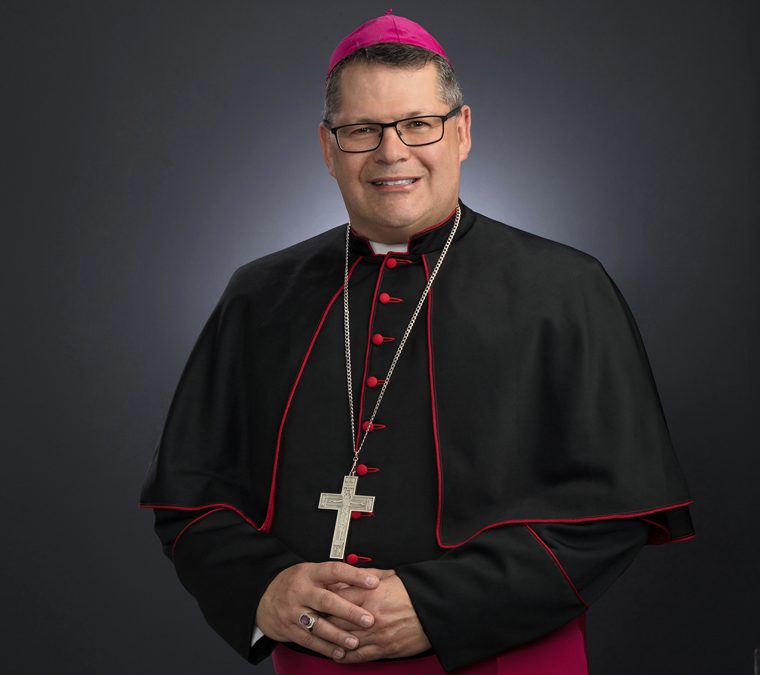As this edition of the Catholic Sun arrives in your homes, we are preparing for our national feast of Thanksgiving. It will be followed closely by the start of the holy season of Advent and the beginning of a new liturgical year. In this moment, I often think of the words of a poem whose words and imagery remain with me. The words describe the November landscape — the fallen leaves, the bare branches, the stillness of creation — but rather than suggesting that these things point to death, the poet surmises that they lead us to the knowledge that “there is still something to wait for!”
In our profession of faith … our statement of beliefs as Christians … that is where the Paschal Mystery — the living, dying and rising of Jesus Christ — directs us to: “There is still something to wait for!” As Bishop Barron notes in Light from Light: A Theological Reflection on the Nicene Creed (Park Ridge, IL: Word on Fire Academic, 2021), the post-resurrection portion of the creed denotes “the renovation, transfiguration, and restoration of the whole person” (p 168).
He ascended into heaven
and is seated at the right hand of the Father.
He will come again in glory
to judge the living and the dead
and his kingdom will have no end.
I believe in the Holy Spirit, the Lord, the giver of life,
who proceeds from the Father and the Son,
who with the Father and the Son is adored and glorified,
who has spoken through the prophets.
I believe in one, holy, catholic and apostolic Church.
I confess one Baptism for the forgiveness of sins
and I look forward to the resurrection of the dead
and the life of the world to come.
St. Symeon, the New Theologian, summarizes for us the orientation of these credal statements: “God the Word, Who by nature has no flesh, took from us and became man, which he was not before. He imparts his own divinity to those who believe in Him — something which neither angels nor men had ever had before — and by adoption and by grace, they became gods who before were not.” The culmination of this thought is found in the words of an ancient Eastern Catholic hymn: “O Jesus … you ascended into heaven and you seated me at the right hand of the Father. In amazement before all these miracles I sing to you” (Source: Fr. Blake Britton, Reclaiming Vatican II, Notre Dame: Ave Maria Press, 2021).
And what does the human chorus sing out through the working of the Holy Spirit — “There is still something to wait for!” — “the life of the world to come.” Thus, we come to the end of our reflection on the Nicene Creed, but there remains one word to be uttered — our “Amen.” Our affirmation expressing “so be it” and affirming the truth contained therein. As the Catechism of the Catholic Church states: “In Hebrew, amen comes from the same root as the word ‘believe.’ This root expresses solidity, trustworthiness, faithfulness. And so we can understand why ‘Amen’ may express both God’s faithfulness towards us and our trust in him” (#1062). It goes on to say: “Thus the Creed’s final ‘Amen’ repeats and confirms its first words: ‘I believe.’ To believe is to say ‘Amen’ to God’s words, promises and commandments; to entrust oneself completely to him who is the ‘Amen’ of infinite love and perfect faithfulness. The Christian’s everyday life will then be the ‘Amen’ to the ‘I believe’ of our baptismal profession of faith” (#1064).
The hallmark of the Church’s great prayer of Thanksgiving — the Mass — is the “Great Amen” at the ending of the Eucharistic Prayer which is known as the Final Doxology. It signifies that Jesus Christ himself is the culmination of God’s Amen of love for the human family (see Catechism #1065). In turn, we are invited to take up the chorus in our own lives — through Him, with Him, and in Him. In the words of the Psalmist: “Every day I will bless you, and I will praise your name forever and ever. Great is the Lord and highly to be praised; his greatness is unsearchable. … Let all your works give you thanks, O Lord, and let your faithful bless you. Let them discourse of the glory of your Kingdom and speak of your might” (Psalm 145:2-3 & 10-11).
Moreover, while giving thanks to “the God of all, who has done wondrous things on earth” (see Sirach 50:22a), we are directed also to the source of our feasting: “[T]he dawn in time of the fullness of time, the entrance into history of the goal of history, the appearance in one man of the ultimate future of all” (Patrick Regan, OSB). Our gathering in thanksgiving is a precursor for “the future full of hope” (see Jer 29:11) — that is, “There is still something to wait for!” — that is heralded in our Advent and Christmas celebrations. Reminiscent of these words our diocesan staff again this year will focus on the Advent theme of “We wait in joyful hope.”
Know that I continue to give thanks to God for the gift the Diocese of Syracuse family is to me; and for the rich blessing I have of such fine and gifted collaborators in ministry! I continue to seek to make our parishes places where all are welcome and wherein all can find their home in God. To this goal I invite all of us to add our “Amen,” as it gives direction into the new year of Grace that will be soon upon us!
Happy Thanksgiving to our Diocesan family and to all our neighbors! Let us together celebrate that “there is still something to wait for!”






